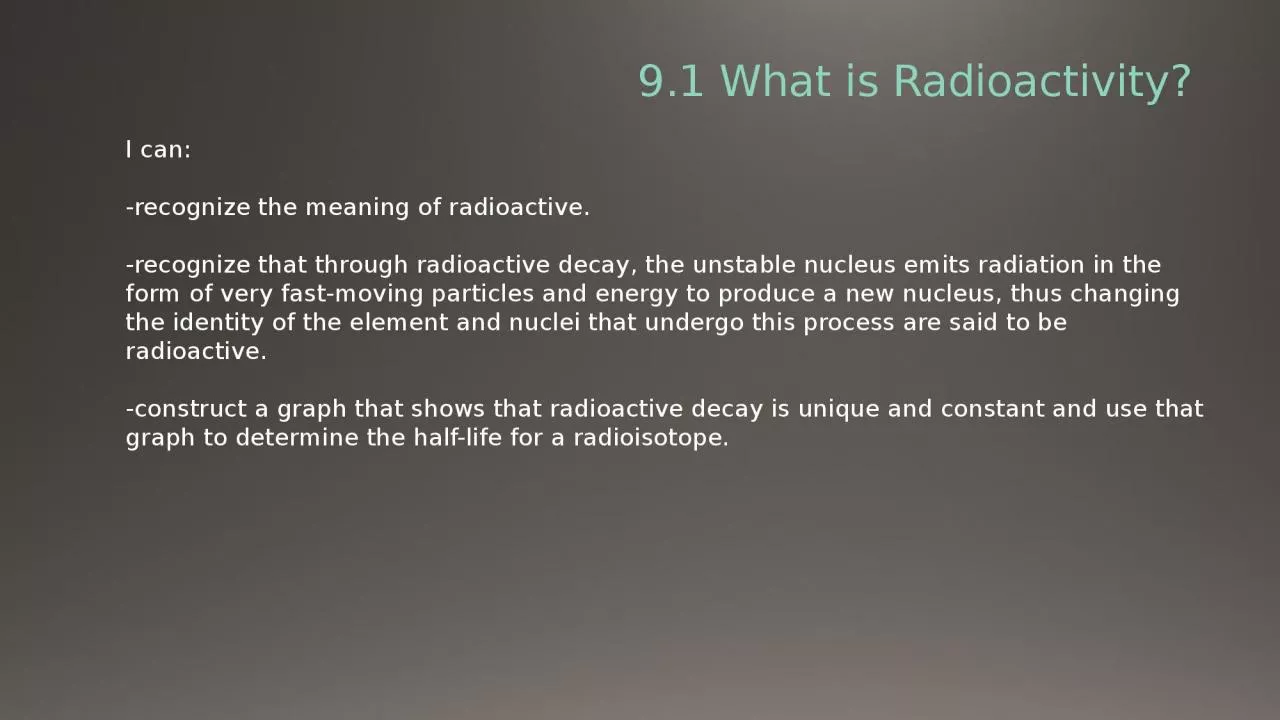

I can recognize the meaning of radioactive recognize that through radioactive decay the unstable nucleus emits radiation in the form of very fastmoving particles and energy to produce a new nucleus thus changing the identity of the element and nuclei that undergo this process are said to ID: 1012780
Download Presentation The PPT/PDF document "9.1 What is Radioactivity?" is the property of its rightful owner. Permission is granted to download and print the materials on this web site for personal, non-commercial use only, and to display it on your personal computer provided you do not modify the materials and that you retain all copyright notices contained in the materials. By downloading content from our website, you accept the terms of this agreement.
1. 9.1 What is Radioactivity?I can:-recognize the meaning of radioactive. -recognize that through radioactive decay, the unstable nucleus emits radiation in the form of very fast-moving particles and energy to produce a new nucleus, thus changing the identity of the element and nuclei that undergo this process are said to be radioactive. -construct a graph that shows that radioactive decay is unique and constant and use that graph to determine the half-life for a radioisotope.
2. Nuclear RadiationRadioactivity: the process by which an unstable nucleus emits one or more particles or energy in the form of electromagnetic radiation. (it just wants to become stable)Nuclear decayisotopes: different numbers of protons than neutrons.Nuclear Radiation: the particles that are released from the nucleus during radioactive decay.Do not confuse this with light radiation.Can be very harmful to the materials that absorb the radiation.
3. When a radioactive nucleus decays, the nuclear radiation leaves the nucleus.
4. Alpha particles (+) consist of protons and neutrons.Uranium is a radioactive element that occurs in 3 isotope forms.Energy source in nuclear power plants.U 234, U 235, U 238, UResponsible for most of the heat in Earth’s core.U 238 undergoes nuclear decay by emitting positively charged particles (Rutherford)Alpha particles (2 protons and two neutrons… He): positively charged atom that is released in the disintegration of radioactive elements and that consists of two protons and two neutrons.So massive they barely travel through a piece of paper.Pull electrons from other matter, thus losing energy as it passing through.
5. Beta particles (-)Travels through matter that alpha particles do not.Only released during certain types of radioactive decay.Fast movingWhen neutrons decay, they form a proton and electron.Electron has little mass and is ejected from nucleus at high speedEasily go through paper, but stopped by aluminum or wood. Like alpha particles, they ionize atoms which slows them down.
6. Gamma rays are very high energyMore penetrating than beta particlesGamma ray: the high-energy photon emitted by a nucleus during fission and radioactive decay.Unlike beta and alpha, they are not made of matter.Photons Have more energy than light or X-raysPose highest danger to health
7. Neutron radioactivity may occur in an unstable nucleusNeutron are not charged, therefore do not ionize matter. Can travel the furthest of all three previously mentioned forms of radioactivity.
8. Nuclear DecayWhen unstable nuclei emit alpha or beta particles, # of proton and neutrons change.Radium-226Radium-222A nucleus gives up two protons and two neutron during alpha decayA nucleus gains a proton and loses a neutron during beta decay.
9. Radioactive Decay RatesHalf-life: the time required for half of a sample of a radioactive substance to disintegrate by radioactive decay.Parent v. daughter material (penny example)
10. Half-Life is a measure of how quickly a substance decays. (Fractions)½,1/4,1/8,1/16,1/32,1/64…Depends on stability of nucleus.Potassium-40=rocksCarbon-14=more recent materials
11.
12. Half-life PracticeThe half-life of iodine-131 is 8.1 days. How long will it take for three-fourths of a sample of iodine-131 to decay?Radon-222 is a radioactive gas with a half-life of 3.82 days. How long would it take for fifteen-sixteenths of a sample of radon-222 to decay?Uranium-238 decays very slowly, with a half-life of 4.47 billion years. What percentage of a sample of uranium-238 would remain after 13.4 billion years?